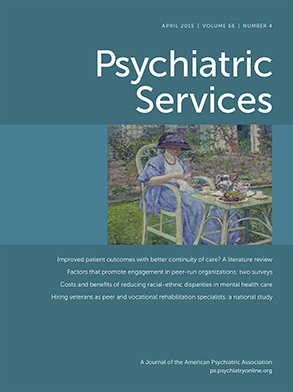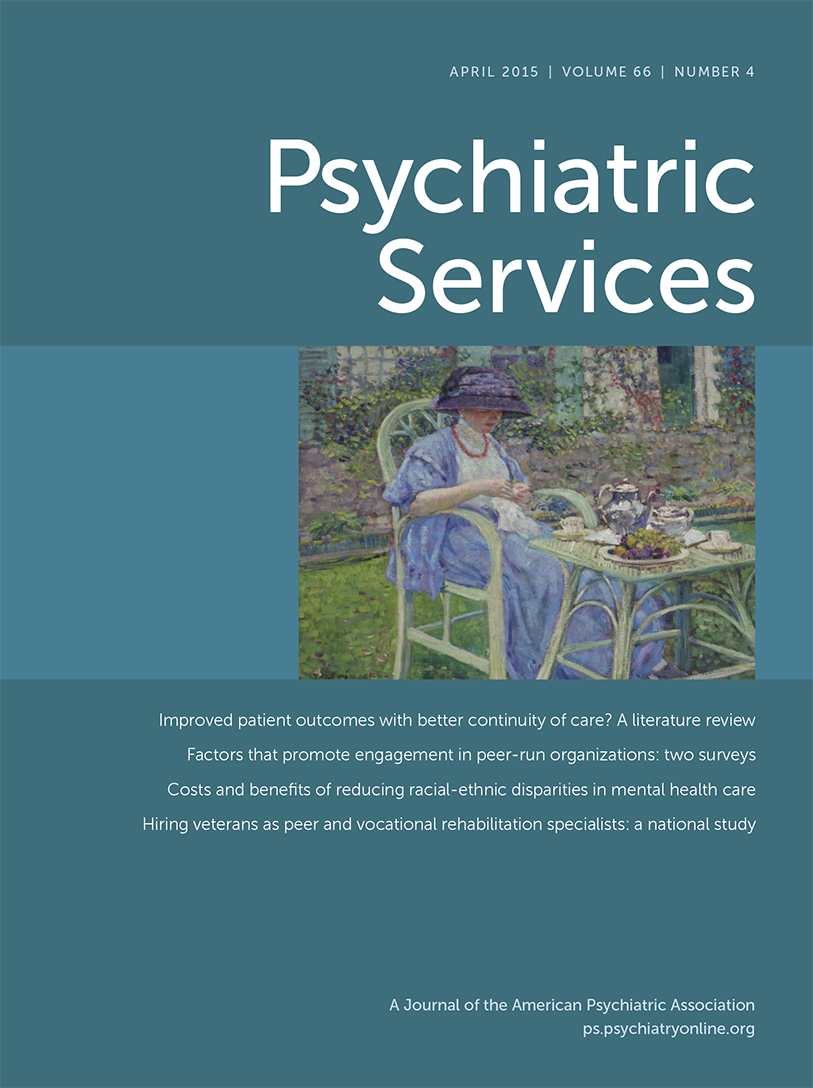Determinants of Engagement in Mental Health Consumer–Run Organizations
Abstract
Objective:
Methods:
Results:
Conclusions:
An Overview of CROs
Individual Characteristics Related to CRO Engagement
Demographic characteristics.
Sense of community.
Organizational empowerment.
Organizational Characteristics Related to CRO Engagement
Group size.
Services provided.
Shared leadership.
The Study and the Hypotheses
Methods
Study Setting
Data Collection Procedure
Study Sample
Measures
CRO engagement.
Individual-level predictors.
Organization-level predictors.
Plan of Analysis
Results
| Variable | N | % | M | SD | Minimum | Maximum |
|---|---|---|---|---|---|---|
| Engagement | ||||||
| Total attendancea | 245 | 716.64 | 1,035.87 | 1 | 5,760 | |
| Leadership involvementb | 250 | 9.91 | 5.85 | 0 | 21 | |
| Socially supportive involvementb | 245 | 3.17 | .62 | 1.36 | 4.00 | |
| Individual characteristic | ||||||
| Perceived sense of communityb | 250 | 2.52 | .33 | 1.56 | 3.00 | |
| Perceived organizational empowermentb | 246 | 4.26 | .59 | 2.55 | 5.00 | |
| Ageb | 234 | 44.21 | 11.21 | 20 | 70 | |
| Educational attainmentb,c | 247 | 2.47 | .93 | 1 | 5 | |
| Less than high school | 35 | 14 | ||||
| High school diploma or GED | 91 | 37 | ||||
| Technical training beyond high school or some college | 100 | 40 | ||||
| Graduated from college | 11 | 4 | ||||
| Graduate degree | 10 | 4 | ||||
| Race-ethnicity | 246 | |||||
| White, non-Hispanic | 194 | 79 | ||||
| Black, non-Hispanic | 19 | 8 | ||||
| Hispanic | 7 | 3 | ||||
| Native American | 4 | 2 | ||||
| Asian | 1 | <1 | ||||
| Mixed | 21 | 9 | ||||
| Relationship status | 249 | |||||
| Single | 115 | 46 | ||||
| Married | 42 | 17 | ||||
| Living with partner | 16 | 6 | ||||
| Separated or divorced | 64 | 26 | ||||
| Widowed | 12 | 5 | ||||
| Gender | 245 | |||||
| Male | 113 | 46 | ||||
| Female | 132 | 54 | ||||
| Organizational characteristic | ||||||
| Membership sizeb | 20 | 58.40 | 50.74 | 9 | 171 | |
| Availability of peer counseling | 20 | |||||
| Available | 5 | 25 | ||||
| Unavailable | 15 | 75 | ||||
| N of self-help group meetings | 20 | 2.15 | 2.68 | 0 | 8 | |
| N of recreational activities | 20 | 8.10 | 4.10 | 4 | 22 | |
| N of members involved in quarterly reports | 19 | 3.05 | 1.93 | 2 | 8 | |
| N of members planning activities | 20 | 8.20 | 5.63 | 2 | 22 |
Univariate Regression Models
| Total attendance | Leadership involvement | Socially supportive involvement | ||||
|---|---|---|---|---|---|---|
| Predictor | IRRa | 95% CI | B | 95% CI | B | 95% CI |
| Individual characteristic | ||||||
| Perceived sense of community | 1.63*** | 1.39 to 1.91 | .40*** | .29 to .52 | .42*** | .31 to .54 |
| Perceived organizational empowerment | 1.08 | .92 to 1.24 | .20** | .08 to .32 | .58*** | .48 to .68 |
| Race-ethnicityb | 1.33 | .88 to 2.00 | .37* | .07 to .66 | .20 | –.10 to .50 |
| Relationship statusc | 1.14 | .83 to 1.58 | –.34** | –.58 to –.10 | .08 | –.17 to .33 |
| Age | 1.21* | 1.02 to 1.43 | .06 | –.06 to .18 | –.08 | –.20 to .05 |
| Educational attainment | 1.12 | .95 to 1.31 | .19** | .07 to .31 | –.13* | –.25 to –.01 |
| Genderd | 1.10 | .80 to 1.52 | –.25* | –.49 to –.01 | .07 | –.18 to .32 |
| Organizational characteristic | ||||||
| Membership size | 1.26 | .85 to 1.88 | –.21* | –.39 to –.02 | .04 | –.15 to .22 |
| Availability of peer counseling | 1.16 | .51 to 2.66 | –.02 | –.46 to .42 | .64*** | .45 to .83 |
| N of self-help group meetings | 1.14* | 1.01 to 1.28 | –.01 | –.09 to .06 | –.05 | –.11 to .01 |
| N of recreational activities | 1.00 | .92 to 1.09 | –.02 | –.07 to .02 | –.01 | –.04 to .03 |
| N of members involved in quarterly reports | 1.21* | 1.01 to 1.45 | .04 | –.06 to .14 | –.01 | –.10 to .08 |
| N of members planning activities | 1.03 | .97 to 1.10 | –.02 | –.06 to .01 | .01 | –.02 to .04 |
Multivariate Regression Models
| Total attendance | Leadership involvement | Socially supportive involvement | ||||
|---|---|---|---|---|---|---|
| Predictor | IRRa | 95% CI | B | 95% CI | B | 95% CI |
| Intercept | 157.35*** | 71.96 to 344.08 | –.22 | –.70 to .26 | –.21 | –.61 to .18 |
| Perceived sense of community | 1.64*** | 1.37 to 1.97 | .38*** | .25 to .50 | .21*** | .11 to .31 |
| Perceived organizational empowerment | .92 | .78 to 1.09 | .06 | –.16 to .18 | .48*** | .36 to .60 |
| Race-ethnicityb | 1.14 | .76 to 1.70 | .10 | –.17 to .38 | .01 | –.24 to .26 |
| Relationship statusc | 1.29 | .89 to 1.79 | –.26* | –.50 to –.03 | .16 | –.007 to .32 |
| Age | 1.12 | .93 to 1.34 | –.06 | –.18 to .06 | –.03 | –.11 to .05 |
| Educational attainment | 1.12 | .95 to 1.31 | .22*** | .11 to .33 | –.09* | –.17 to –.003 |
| Genderd | 1.30 | .93 to 1.82 | –.14 | –.36 to .08 | –.02 | –.21 to .16 |
| Membership size | 1.00 | .99 to 1.00 | –.29** | –.48 to –.10 | .01 | –.08 to .10 |
| Availability of peer counseling | 1.89 | .83 to 4.28 | .03 | –.35 to .40 | .32** | .12 to .51 |
| N of self-help group meetings | 1.15 | .99 to 1.33 | .02 | –.05 to .08 | –.03 | –.06 to .003 |
| N of members involved in quarterly reports | 1.22* | 1.01 to 1.47 | .09* | .001 to .18 | .04 | –.01 to .09 |
Discussion
Individual-Level Characteristics
Organization-Level Characteristics
Limitations and Future Directions
Conclusions
References
Information & Authors
Information
Published In

Cover: Breakfast in the Garden, by Frederick Carl Frieseke, circa 1911. Oil on canvas, 26 x 325/16 inches. Daniel J. Terra Collection, 1987.21. Terra Foundation for American Art, Chicago/Art Resource, New York City.
History
Authors
Competing Interests
Funding Information
Metrics & Citations
Metrics
Citations
Export Citations
If you have the appropriate software installed, you can download article citation data to the citation manager of your choice. Simply select your manager software from the list below and click Download.
For more information or tips please see 'Downloading to a citation manager' in the Help menu.
View Options
View options
PDF/EPUB
View PDF/EPUBLogin options
Already a subscriber? Access your subscription through your login credentials or your institution for full access to this article.
Personal login Institutional Login Open Athens loginNot a subscriber?
PsychiatryOnline subscription options offer access to the DSM-5-TR® library, books, journals, CME, and patient resources. This all-in-one virtual library provides psychiatrists and mental health professionals with key resources for diagnosis, treatment, research, and professional development.
Need more help? PsychiatryOnline Customer Service may be reached by emailing [email protected] or by calling 800-368-5777 (in the U.S.) or 703-907-7322 (outside the U.S.).
